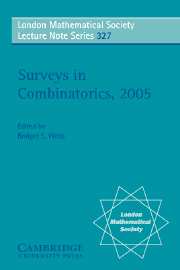Book contents
- Frontmatter
- Contents
- Preface
- 1 Finite field models in additive combinatorics
- 2 The subgroup structure of finite classical groups in terms of geometric configurations
- 3 Constructing combinatorial objects via cliques
- 4 Flocks of circle planes
- 5 Judicious partitions and related problems
- 6 An isoperimetric method for the small sumset problem
- 7 The structure of claw-free graphs
- 8 The multivariate Tutte polynomial (alias Potts model) for graphs and matroids
- 9 The sparse regularity lemma and its applications
2 - The subgroup structure of finite classical groups in terms of geometric configurations
Published online by Cambridge University Press: 04 August 2010
- Frontmatter
- Contents
- Preface
- 1 Finite field models in additive combinatorics
- 2 The subgroup structure of finite classical groups in terms of geometric configurations
- 3 Constructing combinatorial objects via cliques
- 4 Flocks of circle planes
- 5 Judicious partitions and related problems
- 6 An isoperimetric method for the small sumset problem
- 7 The structure of claw-free graphs
- 8 The multivariate Tutte polynomial (alias Potts model) for graphs and matroids
- 9 The sparse regularity lemma and its applications
Summary
Abstract
L.E. Dickson's approach to the subgroups of PSL2(q) (the Linear Fractional Group) gives rise to a description of subgroups as fixing one of: a real point; a pair of real points; a pair of imaginary points; a sub-line; and so on. H.H. Mitchell took a similar approach in describing subgroups of PSL3(q) and PSp4(q) (for odd q). In the 1980s, Aschbacher gave a description of subgroups of classical groups as either lying in one of eight classes or being almost simple; the eight classes can largely be described geometrically. The remaining subgroups have not yet been completely determined but a certain amount of geometric structure can be identified. This paper gives a survey of progress towards a geometric description of subgroups of the classical groups.
Introduction
There are four classes of Classical Group. Perhaps it is most straightforward to name a significant group within each class and to then describe the various related groups in the class. Four significant groups, then, are GLn(q), Spn(q), On(q) and Un(q). We begin by describing these groups in some detail. This paper is a survey of progress towards a geometric description of the subgroup structure of the classical groups. We shall describe Aschbacher's Theorem in some detail, even though Aschbacher's approach is clearly not geometrical, for Aschbacher's Theorem demonstrates very largely the structure that one should expect to find.
- Type
- Chapter
- Information
- Surveys in Combinatorics 2005 , pp. 29 - 56Publisher: Cambridge University PressPrint publication year: 2005
- 37
- Cited by

